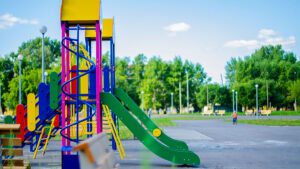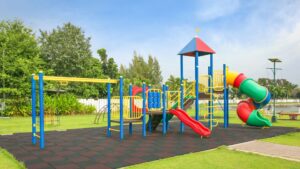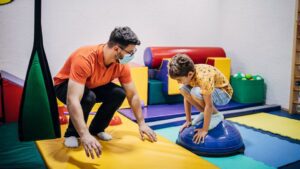Playground swings are timeless favorites that spark joy, encourage social play, and support physical development in children of all ages. Modern parks strive to offer a diverse range of swing styles—classic belt swings, toddler-friendly bucket swings, inclusive adaptive swings, and more—to ensure every child can join the fun. In this guide, we’ll explore the most popular playground swing types, their features, safety considerations, and maintenance tips, helping park planners and parents choose the perfect swings for their play spaces.
1. Introduction
Swings are more than just fun—they promote balance, coordination, and core strength while offering children a sense of freedom. As communities emphasize inclusivity and safety, playground designers now install a variety of swing types, each tailored to different age groups and abilities. Understanding the unique features and requirements of each swing style will help you create a play area that’s both engaging and accessible.
2. Belt Swings
Also known as: Traditional swings, rubber seat swings
Overview:
- Classic single-seat design with a flexible belt of rubber or reinforced fabric.
- Adjustable chain or rope length for toddlers through teens and adults.
Features & Benefits:
- Versatility: Suitable for ages 3–99, supports up to 250 lbs.
- Durability: UV-resistant, weatherproof materials resist cracking.
- Easy Access: Low seat height for self-mounting.
Safety Considerations:
- Inspect attachment hardware and chains monthly for wear.
- Ensure swing arc clear zone (minimum 30 in. on each side).
- Install over impact-absorbing surfacing (rubber mulch, engineered wood fiber).

3. Bucket (Baby) Swings
Also known as: Toddler swings, infant bucket swings
Overview:
- High-backed seat with leg openings and safety straps.
- Prevents young children from sliding out during swinging.
Features & Benefits:
- Secure Fit: Adjustable harness or T-bar restraint.
- Developmental Support: Gentle swinging stimulates vestibular system.
- Parent–Child Bonding: Allows caregivers to push and interact.
Safety Considerations:
- Weight limit typically 50 lbs; remove as child gains confidence.
- Check belt integrity and tightening mechanisms regularly.
- Supervise toddlers at all times.

4. Glider Swings
Also known as: Tandem swings, two-person swings
Overview:
- Bench-like seat designed for two or more users facing each other.
- Moves back and forth along a fixed beam or arm.
Features & Benefits:
- Social Play: Encourages cooperative pushing and riding.
- Moderate Exercise: Works upper body and leg muscles for pushing.
- Unique Motion: Rhythmic rocking appeals to a range of ages.
Safety Considerations:
- Secure footrests and handholds to prevent slips.
- Maintain smooth gliding track; clear debris.
- Limit to recommended user capacity.

5. Adaptive (Inclusive) Swings
Also known as: Accessible swings, disability-friendly swings
Overview:
- Specially designed seats (full bucket, bench with backrest, harness).
- Accommodates children with mobility challenges or sensory sensitivities.
Features & Benefits:
- Inclusivity: Ensures children of all abilities can swing safely.
- Supportive Seating: Additional back support and belts.
- Community Integration: Fosters inclusive play environments.
Safety Considerations:
- Use secure 5-point harnesses for added stability.
- Install on flat, firm surfaces with ADA-compliant pathways.
- Provide nearby seating for caregivers.

6. Tire Swings
Also known as: Rotary swings, recycled-tire swings
Overview:
- Repurposed vehicle tire hung horizontally or vertically by chains.
- Multiple children can sit or stand.
Features & Benefits:
- Eco-Friendly: Reuses old tires, reducing waste.
- Multi-User: Encourages group play and sharing.
- Sensory Input: Provides spinning and swinging sensations.
Safety Considerations:
- Smooth inner tire surface or add padding to prevent pinch points.
- Check tire integrity for cuts or weak spots.
- Clear surrounding area of obstructions.

7. Nest (Basket) Swings
Also known as: Bird’s nest swings, hammock swings
Overview:
- Large circular webbed net or fabric bed suspended from a frame.
- Accommodates multiple children lying or sitting together.
Features & Benefits:
- Group Interaction: Promotes social and cooperative play.
- Comfort: Soft, hammock-like lounging experience.
- Sensory-Friendly: Gentle rocking is calming for sensory seekers.
Safety Considerations:
- Weight capacity up to 600 lbs; limit users accordingly.
- Inspect webbing for frays or tears.
- Ensure even weight distribution to avoid tipping.

8. Disc and Saucer Swings
Also known as: Flying saucer swings, pod swings
Overview:
- Single-seat circular platform made of plastic or fabric.
- Swinging achieved by rope or chain, often allowing spinning.
Features & Benefits:
- Fun Factor: Combines swinging with spinning motion.
- Compact Footprint: Fits small play areas.
- Single or Dual Use: Some models support two children.
Safety Considerations:
- Ensure swing is free to rotate without tangling.
- Maintain smooth rope/chain connections.
- Supervise spinning to prevent dizziness-related falls.

9. Chain‑Linked Family Swings
Also known as: Platform swings, group swings
Overview:
- Large rectangular or triangular platform suspended by multiple chains.
- Designed for group swinging or wheelchair access.
Features & Benefits:
- Universal Design: Accommodates wheelchairs and strollers.
- Group Play: Perfect for collaborative pushing and socializing.
- Sturdy Construction: Heavy-duty chains and durable platform.
Safety Considerations:
- Confirm ADA compliance for wheelchair users.
- Inspect multiple suspensions for even wear.
- Install guardrails on platform edges.

10. Safety Tips and Maintenance
Regular Inspections:
- Weekly visual checks for wear, corrosion, loose bolts.
- Monthly function tests—ensure smooth swing action.
Surface Requirements:
- 6 ft clear zone in front and behind each swing.
- Impact-absorbing surfacing (rubber mulch, poured rubber, sand) at least 12 inches deep.
Hardware Care:
- Lubricate moving parts to prevent squeaks and binding.
- Replace worn chains or ropes immediately.
User Guidelines:
- Post age and capacity limits on swing sets.
- Encourage single‑file swinging and no jumping from seat.
Winterizing:
- Remove belt and soft seats during freezing temperatures.
- Cover metal components or apply rust‑inhibitor paint.

11. Conclusion
Selecting the right mix of playground swings enhances fun, encourages inclusive play, and supports children’s physical and social development. From classic belt swings to specialized adaptive seats, each type offers unique benefits and design considerations. By following safety guidelines and routine maintenance, parks and playgrounds can provide a vibrant, welcoming environment where every child can experience the simple joy of swinging.




